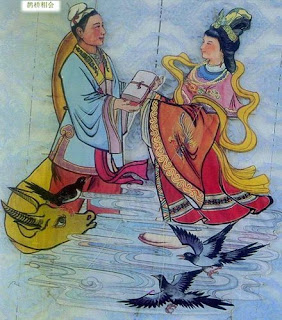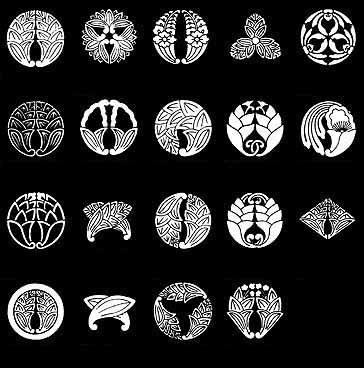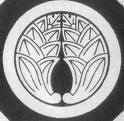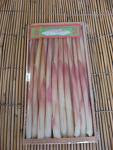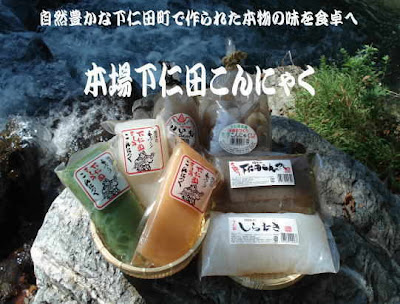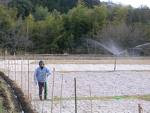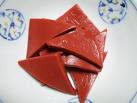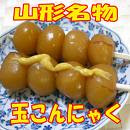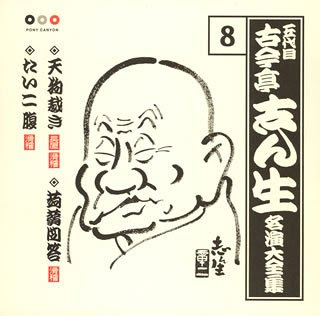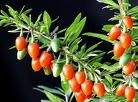::::::::::::::::::::::::::::::::::::::::::::::::::::::::::::::::::::::::::::::::::::::::::::::::::::
Garlic (ninniku)
***** Location: Japan
***** Season:
***** Category: Humanity
*****************************
Explanation
ninniku 蒜 (にんにく(ニンニク)) garlic
..... 葫(にんにく). goro ころ【葫蘆/胡蘆】
..... hiru ひる【蒜/葫】
ooninniku, oo-ninniku 大蒜(おおにんにく) "big garlic"
. . . CLICK here for Photos !
Allium sativum.
kigo for mid-spring
nobiru no hana 野蒜の花 (のびるのはな )
blossoms of the wild garlic
kigo for early summer
ninniku no hana 蒜の花 ( にんにくのはな)
blossoms of the garlic
kigo for late summer
Knoblauch

Varieties with less strong smell are grown in Japan.
:::::::::::::::::::::::::::::::::::::::::::::::::::::::::::::::::::::::::::::::::::::::::::::::::::
quote
Allium sativum L., commonly known as garlic,
is a species in the onion family Alliaceae. Its close relatives include the onion, shallot, leek, and chive. Garlic has been used throughout recorded history for both culinary and medicinal purposes. It has a characteristic pungent, spicy flavor that mellows and sweetens considerably with cooking.
Single clove garlic (also called Pearl garlic or Solo garlic) also exists -- it originates in the Yunnan province of China. The cloves are used as seed, for consumption (raw or cooked), and for medicinal purposes. The leaves, stems (scape), and flowers (bulbils) on the head (spathe) are also edible and are most often consumed while immature and still tender.
Garlic is easy to grow and can be grown year-round in mild climates.
Garlic is widely used around the world for its pungent flavor as a seasoning or condiment.
Oils are often flavored with garlic cloves.
Immature scapes are tender and edible. They are also known as "garlic spears," "stems," or "tops." Scapes generally have a milder taste than cloves. They are often used in stir frying or prepared like asparagus. Garlic leaves are a popular vegetable in many parts of Asia. The leaves are cut, cleaned, and then stir-fried with eggs, meat, or vegetables.
Mixing garlic with eggs and olive oil produces aioli. Garlic, oil, and a chunky base produce skordalia. Blending garlic, almond, oil, and soaked bread produces ajoblanco.
About 1/4 teaspoon of dried powdered garlic is equivalent to one fresh clove.
Galen eulogizes it as the "rustic's theriac" (cure-all).
Garlic is claimed to help prevent heart disease (including atherosclerosis, high cholesterol, and high blood pressure) and cancer.
Garlic is also alleged to help regulate blood sugar levels.
In modern naturopathy, garlic is used as a treatment for intestinal worms and other intestinal parasites, both orally and as an anal suppository. Garlic cloves are used as a remedy for infections (especially chest problems), digestive disorders, and fungal infections such as thrush.
Garlic is known for causing halitosis as well as causing sweat to have a pungent 'garlicy' smell which is caused by Allyl methyl sulfide (AMS).
When crushed, Allium sativum yields allicin, a powerful antibiotic and antifungal compound (phytoncide). A large number of sulfur compounds contribute to the smell and taste of garlic.
In the account of Korea's establishment as a nation, gods were said to have given mortal women with bear and tiger temperaments an immortal's black garlic before mating with them. This is a genetically unique six-clove garlic that was to have given the women supernatural powers and immortality. This garlic is still cultivated in a few mountain areas today.
Garlic has been regarded as a force for both good and evil.
In Taoism mythology, six-clove black garlic is used as part of the process of modifying a Taoist's genetics. It supposedly endows the users immortality by intensifying their vital energy or "chi."
The association of garlic to evil spirits may be based on the antibacterial, antiparasitic value of garlic, which could prevent infections that lead to delusions and other related mental illness symptoms.
In both Hinduism and Jainism, garlic is considered to stimulate and warm the body and to increase one's desires. Hindus generally avoid using garlic and the related onion in the preparation of foods for religious festivities and events. Followers of the Jain religion avoid eating garlic and onion on a daily basis.
In connection with the odor associated with garlic, Islam views eating garlic and subsequently going to the mosque as inappropriate. "Whoever has eaten (garlic) should not approach our mosque," indicated Muhammad.
It should be made clear that the logical reason for this injunction is the pungent scent or odour exuded by garlic which could be uncomfortable with.
© More in the WIKIPEDIA !
:::::::::::::::::::::::::::::::::::::::::::::::::::::::::::::::::::::::::::::::::::::::::::::::::::::
Garlic in Japan
In Aomori there is a "Garlic Market" at the shrine Kishinja
鬼神社 ninniku ichi "ニンニク市" in Hirosaki town
. . . CLICK here for Photos of the shrine!
"Garlic festival" ninniku matsuri ニンニク祭り
at the shrine Ichi no Yasaka jinja 一ノ矢八坂神社 in Tochigi.
From June 6 to June 14.
Lately only on the 7th of this month.
. . . CLICK here for Photos of the shrine !
for the deity Gozuu Tennoo 午頭天王.
This deity can ward off evil and disease and during the festival garlic is distributed among the visitors. The deity brought garlic with him from Korea, together with knowledge about iron melting, casting metal, planting forests and making herbal medicine.
During the Tenmei-famine in the Edo period garlic kept the villagers alive and the daimyo of the domain, Hotta Tajima 堀田対馬守 allowed this festival to be held. They also sold "Garlic talismans" ninniku omamori ニンニクお守り .
Apart from garlic, trees and plants are sold at the open market.
. . . CLICK here for Photos !
WASHOKU : 葷酒山門(くんしゅさんもん)kunshu sanmon
Temple Gate, no garlic or liquor beyond this point!
:::::::::::::::::::::::::::::::::::::::::::::::::::::::::::::::::::::::::::::::::::::::::::::::::::
The following items are NOT kigo for haiku.
Garlic smells stronger if more of its surface is exposed to air. Therefore there are cooking methods to improve the smell.
You can also just scrab the edges of your salad bowl with a freshly cut garlic clove to get the smell on the dish, but not on the food. So you can enjoy the garlic aroma but your breath is fine after eating.

press to squeeze garlic cloves にんにくしぼり
ninniku shibori
oroshi ninniku おろしにんにく grated garlic

ninniku no tataki にんにく たたく
Hitting the garlic clove with the back of the knife to squeeze it.
:::::::::::::::::::::::::::::::::::::::::::::::::::::::::::::::::::::::::::::::::::::::::::::::::::::

ガーリック(にんにく)料理
Garlic Dishes
Kochen mit Knoblauch
薩摩 醗酵黒にんにく卵黄
Kumamoto
Garlic with Egg Yolk
The women of Satsuma prepared garlic cloves with eggyolk into pills (ninnikudama にんにく玉) which the samurai could take on their long walk to Edo, which took as much as 40 days for the 1.700 kilometers. So it was tough walking of 30 kilometers every day and you had to stay healthy.
The first trip of a daimyo from Satsuma in 1607 was made by 1.180 retainers ... ! and later even 2000 people walked along with the Lord.
Sometimes the garlic was fermented before making the pills until it was all black and thus had even more power than white garlic.

Until today, this mix is used as medicine by many.
Mixed with the yolk of eggs from "black chicken" ukkokei 黒鶏 it is even better.
The calcium of the egg shells is also included in the medicine.
Aomori Ninniku 青森ニンニク Garlic from Aomori
. . . CLICK here for Photos !
Yoshino gaarikku 吉野ガーリック giant garlic from Yoshinogari 吉野ヶ里
Saga, Kyushu
:::::::::::::::::::::::::::::::::::::::::::::::::::::::::::::::::::::::::::::::::::::::::::::::::::

gyooja ninniku 行者大蒜(ギョウジャニンニク )
"garlic for mountain ascetics"
wild onion, Ainu onion, Ainu negi
Allium victorialis L. subsp. platyphyllum.
Washoku : Hokkaido and the Ainu garlic
gyoojana 行者菜 Gyojana,
"green chives for mountain ascetics"
This is a new crossbreed between the garlic and a kind of Chinese chives (nira). It can be grown on fields in shorter time and freshly harvested throughout the year. It is a new cash crop of Yamagata prefecture and the area around the Three Holy Mountains of Deva. It is used like nira Chinese chives.
It is one of the results of the
daikon samitto 大根サミット Radish Summit Daikon Sumit
in 2005, where members of Nagai Town and Utsunomiya University started to work together to introduce new vegetables (shin yasai 新野菜 ). Since 2006 it has been planted by 7 farmers of Nagai Town 山形県長井市.
It can be used for many dishes of the Chinese cuisine, but also for salads and on pizza.
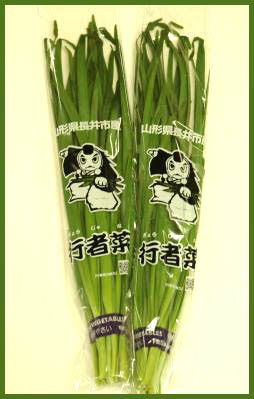
gyoojana ya
I climb the mountains
of my dreams
Gabi Greve, December 2009
:::::::::::::::::::::::::::::::::::::::::::::::::::::::::::::::::::::::::::::::::::::::::::::::::::

ninniku shiso にんにくしそ/ のにんにく紫蘇
garlick pickled with red perilla leaves
shiso ninniku 紫蘇にんにく
umeshiso ninniku 梅しそにんにくwith plums and red perilla leaves
ninnikujooyu, ninniku shooyu にんにく醤油 garlic cloves pickled in soy sauce
Pickled Garlic in Soy Sauce
. . . CLICK here for Photos !
In Sojasauce eingelegter Knoblauch
Katsuo no tataki 鰹のタタキ bonito sashimi with garlic
ninniku chippu にんにくチップ fried garlic chips
slices fried with olive oil
ninniku hachimitsuzuke にんにくのはちみつ漬け
garlic slices soaked in honey for 2 months
ninniku marugoto age にんにくのまるごと揚げ
fried garlic cloves in oil, add lemon juice or miso as condiments.
ninniku miso くにんにく味噌 / miso ninniku 味噌ニンニク
miso paste mixed with garlic
genki miso 元気みそ "healthy miso" with a lot of garlic
. . . CLICK here for Photos !
ninniku sarada にんにくサラダ
salad with garlic,
and cucumbers, tomatoes, onion slices and roasted pork.
ninniku shuu にんにく酒 sake with garlic
500 g garlic, 1.8 liter rice wine 35% alcohol, 250g sugar
ripen for 2 months while shaking the container.
saba no ninniku ni さばのにんにく煮
cooked mackerel with garlic
sashimi,ninniku no sashimi にんにくの刺身
garlic slices "sashimi" with soy sauce
*****************************
Worldwide use
. . . Garlic and vampires, Dracula
*****************************
Things found on the way
Japanese Satsuma Garlic-bulb Vases

fujiya antiques
:::::::::::::::::::::::::::::::::::::::::::::::::::::::::::::::::::::::::::::::::::::::::::::::::::::
Hiruzen Highlands 蒜山高原 Hiruzen mountain range
where the Sun Goddess hid in a cave and later returned.
. Okayama prefecture .
*****************************
HAIKU
にんにくを利かそ明日は日曜日
ninniku o kikaso asu wa nichiyoobi
let the garlic
work its wonders ...
tomorrow is sunday
高尾方子(マサコ) Takao Masako
:::::::::::::::::::::::::::::::::::::::::::::::::::::::::::::::::::::::::::::::::::::::::::::::::::::
毒舌を吐く蒜をすりおろし
dokuzetsu o haku ninniku o suri-oroshi
speaking poisonos
words while grating
garlic
岩本あき子 Iwamoto Akiko
dokuzetsu spiteful tongue, malicious language
*****************************
Related words
***** Garlic chives (nira)
Allium tuberosum, Garlic chives
***** Welch Onion Head (negi boozu)
***** WASHOKU : INGREDIENTS
:::::::::::::::::::::::::::::::::::::::::::::::::::::::::::::::::::::::::::::::::::::::::::::::::::









